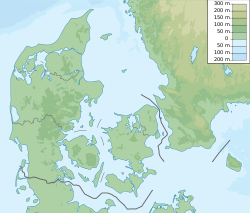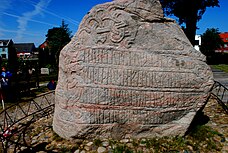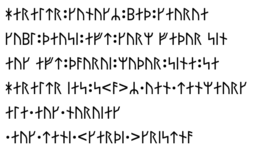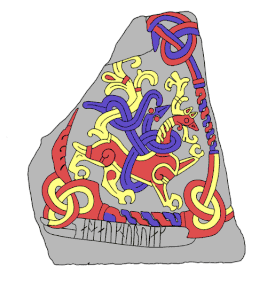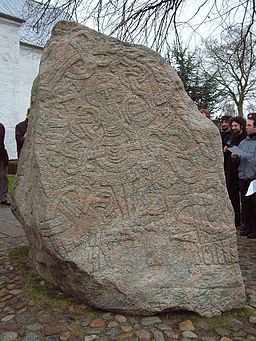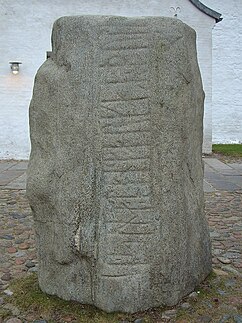Jelling stones
| UNESCO World Heritage Site | |
|---|---|
 Jelling stones, in their glass casing (2012) | |
| Location | Jelling, Denmark |
| Criteria | Cultural: iii |
| Reference | 697 |
| Inscription | 1994 (18th Session) |
| Area | 4.96 ha |
| Coordinates | 55°45′24″N 9°25′10″E / 55.75667°N 9.41944°E |
The Jelling stones (Danish: Jellingstenene) are massive carved runestones from the 10th century, found at the town of Jelling in Denmark. The older of the two Jelling stones was raised by King Gorm the Old in memory of his wife Thyra. The larger of the two stones was raised by King Gorm's son, Harald Bluetooth, in memory of his parents, celebrating his conquest of Denmark and Norway, and his conversion of the Danes to Christianity.
The runic inscriptions on these stones are considered the best known in Denmark.[1] In 1994, the stones, in addition to the burial mounds and small church nearby, were inscribed on the UNESCO World Heritage List as an unparalleled example of both pagan and Christian Nordic culture.[2]
Significance
[edit]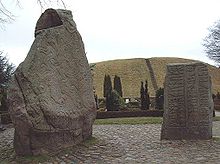
The stones are strongly identified with the creation of Denmark as a nation state. Both inscriptions mention the name "Danmark" (in the form of accusative "tanmaurk" ([dɑnmɒrk]) on the large stone, and genitive "tanmarkar" (pronounced [dɑnmɑrkɑɹ̻̊˔]) on the small stone).[3]
The larger stone explicitly mentions the conversion of Denmark from Norse paganism and the process of Christianisation, alongside a depiction of the crucified Christ; it is therefore popularly dubbed "Denmark's baptismal certificate" (Danmarks dåbsattest), an expression coined by art historian Rudolf Broby-Johansen in the 1930s.[4] In 1997 a photo of this stone inspired the name Bluetooth for the now-ubiquitous wireless standard.

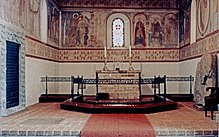
Recent history
[edit]After having been exposed to the elements for a thousand years, cracks were beginning to show. On 15 November 2008 experts from UNESCO examined the stones to determine their condition. Experts requested that the stones be moved to an indoor exhibition hall, or in some other way protected in situ, to prevent further damage from the weather.[5]
In February 2011 the site was vandalized using green spray paint, with the word "GELWANE" written on both sides of the larger stone, and with identical graffiti sprayed on a nearby gravestone and on the church door.[6] After much speculation about the possible meaning of the enigmatic word "gelwane",[7] the vandal was eventually discovered to be a 15-year-old boy with Asperger's syndrome and the word itself was meaningless.[8][9][10] As the paint had not fully hardened,[9] experts were able to remove it.[11]
The Heritage Agency of Denmark decided to keep the stones in their current location and selected a protective casing design from 157 projects submitted through a competition. The winner of the competition was Nobel Architects.[12] The glass casing creates a climate system that keeps the stones at a fixed temperature and humidity and protects them from weathering.[13] The design features rectangular glass casings strengthened by two solid bronze sides mounted on a supporting steel skeleton. The glass is coated with an anti-reflective material that gives the exhibit a greenish hue. Additionally, the bronze patina gives off a rusty, greenish colour, highlighting the runestones' grey and reddish tones and emphasising their monumental character and significance.[13]
Runestone of Harald Bluetooth
[edit]The inscription on the larger of the two Jelling stones (Jelling II, Rundata DR 42[14]) reads:
- runes
- rune transliteration
- Old West Norse normalization
- Old East Norse normalization
:
ᚼᛅᚱᛅᛚᛏᚱ
haraltr
Haraldr
Haraldr
᛬
:
ᚴᚢᚾᚢᚴᛦ
kunukʀ
konungr
kunungʀ
᛬
:
ᛒᛅᚦ
baþ
bað
baþ
᛬
:
ᚴᛅᚢᚱᚢᛅ
kaurua
gera
gørwa
/
¶
ᚴᚢᛒᛚ
kubl
kuml
kumbl
᛬
:
ᚦᛅᚢᛋᛁ
þausi
þessi
þøsi
᛬
:
ᛅᚠᛏ
aft
ept
æft
᛬
:
ᚴᚢᚱᛘ
kurm
Gorm,
Gorm,
ᚠᛅᚦᚢᚱ
faþur
fǫður
faþur
ᛋᛁᚾ
sin
sinn,
sin,
/
¶
ᛅᚢᚴ
auk
ok
ok
ᛅᚠᛏ
aft
ept
æft
᛬
:
ᚦᚭᚢᚱᚢᛁ
þourui
Þyrvé,
Þorwi,
᛬
:
ᛘᚢᚦᚢᚱ
muþur
móður
moþur
᛬
:
ᛋᛁᚾᛅ
sina
sína,
sina,
᛬
:
ᛋᛅ
sa
sá
sa
/
¶
ᚼᛅᚱᛅᛚᛏᚱ
haraltr
Haraldr
Haraldr
(᛬)
(:)
ᛁᛅᛋ
ias
er
æs
᛬
:
ᛋᚭᛦ
soʀ
sér
seʀ
᛫
·
ᚢᛅᚾ
uan
vann
wan
᛫
·
ᛏᛅᚾᛘᛅᚢᚱᚴ
tanmaurk
Danmǫrk
Danmork
King Haraldr ordered these monuments made in memory of Gormr, his father, and in memory of Þyrvé, his mother; that Haraldr who won for himself all of Denmark
ᛅᛚᛅ
ala
alla
alla
᛫
·
ᛅᚢᚴ
auk
ok
ok
᛫
·
ᚾᚢᚱᚢᛁᛅᚴ
nuruiak
Norveg
Norwæg
and Norway
᛫
(·)
ᛅᚢᚴ
auk
ok
ok
᛫
ᛏ(ᛅ)ᚾᛁ
t(a)ni
dani
dani
(᛫
ᚴᛅᚱᚦᛁ
(k)(a)(r)(þ)(i)
gerði
gærþi
᛫)
ᚴᚱᛁᛋᛏᚾᚭ
kristno
kristna.
kristna.
and made the Danes Christian.[14]
The stone has a figure of the crucified Christ on one side and on another side a serpent wrapped around a lion. Christ is depicted as standing in the shape of a cross and entangled in what appear to be branches.[15] This depiction of Christ has often been taken as indicating the parallels with the "hanging" of the Norse pagan god Odin, who in Rúnatal gives an account of being hanged from a tree and pierced by a spear.[15]
animal engraving & Norway claim
reconstruction of original colours
crucifixion scene & Danish baptism claim
coloured, from the VIKING exhibition at the National Museum of Denmark
Modern copies of the runestone of Harald Bluetooth
[edit]
Another copy of this stone was placed in 1936 on the Domplein ('Dom Square') in Utrecht in the Netherlands, next to the Cathedral of Utrecht, on the occasion of the 300th anniversary of Utrecht University.
In 1955, a plaster cast of this stone was made for a festival in London. It is now located in the grounds of the Danish Church in London, 4 St Katherines Precinct, Regents Park, London. The copy is painted in bright colours, like the original. Most of the original paint has flaked away from the original stone, but enough small specks of paint remained to enable the determination of what the colours looked like when they were freshly painted. A copy is also located in the National Museum of Denmark, and another copy, decorated by Rudolf Broby-Johansen in the 1930s, just outside the Jelling museum, which stands within sight of the Jelling mounds.[16]
A copy exists in Rouen, Normandy, France, near Saint-Ouen Abbey Church, offered by Denmark to the city of Rouen, on the occasion of the millennium of Normandy in 1911.
A facsimile of the image of Christ on Harald's runestone appears on the inside front cover of Danish passports.[17]
Runestone of Gorm
[edit]The inscription on the older and smaller of the Jelling stones (Jelling I, Rundata DR 41[18]) reads:
- runes
- rune transliteration
- Old West Norse normalisation
- Old East Norse normalisation
᛬
:
ᚴᚢᚱᛘᛦ
kurmʀ
Gormr
Gormʀ
᛬
:
ᚴᚢᚾᚢᚴᛦ
kunukʀ
konungr
kunungʀ
᛬
: ¶ :
ᚴ(ᛅᚱ)ᚦᛁ
k(a)(r)þi
gerði
gærþi
᛬
:
ᚴᚢᛒᛚ
kubl
kuml
kumbl
᛬
:
ᚦᚢᛋᛁ
þusi
þessi
þøsi
᛬
: ¶ :
ᛅ(ᚠᛏ)
a(f)(t)
ept
æft
᛬
:
ᚦᚢᚱᚢᛁ
þurui
Þyrvé,
Þorwi,
᛬
:
ᚴᚢᚾᚢ
kunu
konu
kunu
King Gormr made these monuments in memory of Þyrvé,
᛬
⁓
ᛋᛁᚾᛅ
sina
sína,
sina,
᛬
⁓
ᛏᛅᚾᛘᛅᚱᚴᛅᛦ
tanmarkaʀ
Danmarkar
Danmarkaʀ
᛬
⁓
ᛒᚢᛏ
but
bót.
bot.
᛬
⁓
his wife, Denmark's salvation.[18]
See also
[edit]- Boris stones — similar landmarks in Belarus
- Curmsun Disc
- Bornholm amulet
- Haraldskær Woman
- Jelling stone ship — a ship setting that lay between the mounds
- Jelling style
- List of runestones
- Tourism in Denmark
References
[edit]- ^ Jelling stones. Encyclopædia Britannica. 2008.
- ^ "Jelling Mounds, Runic Stones and Church". UNESCO World Heritage Centre. United Nations Educational, Scientific, and Cultural Organization. Retrieved 19 Jun 2021.
- ^ Thunberg, Carl L. (2012). Att tolka Svitjod [Interpreting Svitjod] (in Swedish). University of Gothenburg. p. 15. ISBN 978-91-981859-4-2.
- ^ Lokalhistorie fra Sydøstjylland [Local history from Southeast Jutland] (PDF) (in Danish). Historisk Samfund for Sydøstjylland og bidragyderne. 2010. p. 83. ISBN 978-87-92571-07-6. Archived from the original (PDF) on 2021-09-05.
- ^ "Eksperter: Runestenene skal reddes" [Experts: The runestones must be saved] (in Danish). DR (broadcaster). 16 November 2008. Retrieved 16 November 2008.
- ^ Lützhøft, Mette (12 Feb 2011). "Jellingstenene hærget af graffiti" [The Jelling stones ravaged by graffiti]. Politiken (in Danish).
- ^ Nielsen, Finn Årup (18 Feb 2011). "More Jelling Stones graffiti: Gelwane the Second and Web mining".
- ^ "16-årig bag graffiti på Jellingesten skal i behandling" [16-year-old behind graffiti on Jellinge stone needs treatment]. Politiken (in Danish). 13 Aug 2012.
- ^ a b Ritzau (20 February 2011). "Jellingstenen skal renses hurtigst muligt" [The Jelling stone must be cleaned as soon as possible]. Kristeligt Dagblad (in Danish). Archived from the original on 1 Oct 2017. Retrieved 3 April 2017.
- ^ "Gelwane". The Mutual Charter. Archived from the original on 1 Oct 2017.
- ^ Skarum, Sarah (7 March 2011). "Jellingstenen er reddet - næsten" [The Jelling stone is saved - almost]. Berlingske (in Danish). Archived from the original on 4 April 2017. Retrieved 3 April 2017.
- ^ "Jelling Stones get designer cases". The Copenhagen Post. 5 March 2010. Archived from the original on 15 March 2010.
- ^ a b Nobel, Erik (2012-05-31). "Covering of the runic stones in Jelling, Denmark". Copper Concept. Archived from the original on 2013-04-14. Retrieved 13 July 2012.
- ^ a b c d e "Runic inscription DR 42". Scandinavian Runic-text Database (2020 ed.). Uppsala University: Department of Scandinavian Languages. Retrieved Feb 23, 2024.
- ^ a b Kure, Henning (2007). "Hanging on the World Tree: Man and Cosmos in Old Norse Mythic Poetry". In Andrén, Anders; Jennbert, Kristina; et al. (eds.). Old Norse Religion in Long-Term Perspectives: Origins, Changes, and Interactions. Lund: Nordic Academic Press. pp. 68–73. ISBN 978-91-89116-81-8. pp. 69–70.
- ^ "Jellingstenen - en del af historiekanonen" [The Jelling stone - part of the canon of history]. Danmarks Undervisningsportal (in Danish). EMU. Archived from the original on 16 November 2009.
- ^ "DNK-AO-05001 <Cover - front, inside>". Council of Europe. Archived from the original on 2012-07-17. Retrieved 2012-07-17.
- ^ a b c d e "Runic inscription DR 41". Scandinavian Runic-text Database (2020 ed.). Uppsala University: Department of Scandinavian Languages. Retrieved Feb 23, 2024.
Further reading
[edit]- Hogan, C. Michael. "Jelling Stones", Megalithic Portal, editor Andy Burnham
- Jacobsen, Lis; Moltke, Erik (1941–42). Danmarks Runeindskrifter. Copenhagen: Ejnar Munksgaards Forlag.

